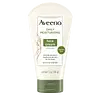What's inside
What's inside
 Key Ingredients
Key Ingredients

 Benefits
Benefits

 Concerns
Concerns

 Ingredients Side-by-side
Ingredients Side-by-side

Colloidal Oatmeal 1%
AbsorbentWater
Skin ConditioningGlycerin
HumectantRicinus Communis Seed Oil
MaskingParaffinum Liquidum
EmollientCetyl Alcohol
EmollientGlyceryl Stearate
EmollientCaprylic/Capric Triglyceride
MaskingOctyldodecanol
EmollientCetyl Palmitate
EmollientPEG-40 Stearate
EmulsifyingGlycyrrhiza Inflata Root Extract
Skin ConditioningCeramide NP
Skin Conditioning1,2-Hexanediol
Skin ConditioningPhenoxyethanol
PreservativePiroctone Olamine
PreservativeCaprylyl Glycol
EmollientEthylhexylglycerin
Skin ConditioningBenzyl Alcohol
PerfumingCitric Acid
BufferingColloidal Oatmeal 1%, Water, Glycerin, Ricinus Communis Seed Oil, Paraffinum Liquidum, Cetyl Alcohol, Glyceryl Stearate, Caprylic/Capric Triglyceride, Octyldodecanol, Cetyl Palmitate, PEG-40 Stearate, Glycyrrhiza Inflata Root Extract, Ceramide NP, 1,2-Hexanediol, Phenoxyethanol, Piroctone Olamine, Caprylyl Glycol, Ethylhexylglycerin, Benzyl Alcohol, Citric Acid
Water
Skin ConditioningGlycerin
HumectantDicaprylyl Ether
EmollientStearic Acid
CleansingCaprylic/Capric Triglyceride
MaskingCetyl Alcohol
EmollientAvena Sativa Kernel Flour
AbrasiveCetearyl Alcohol
EmollientDimethicone
EmollientPhenoxyethanol
PreservativeCarbomer
Emulsion StabilisingCaprylyl Glycol
EmollientCeteareth-20
CleansingSodium Hydroxide
BufferingSodium Citrate
BufferingCitric Acid
Buffering
 Reviews
Reviews

Ingredients Explained
These ingredients are found in both products.
Ingredients higher up in an ingredient list are typically present in a larger amount.
This ingredient is an emollient, solvent, and texture enhancer. It is considered a skin-softener by helping the skin prevent moisture loss.
It helps thicken a product's formula and makes it easier to spread by dissolving clumping compounds.
Caprylic Triglyceride is made by combining glycerin with coconut oil, forming a clear liquid.
While there is an assumption Caprylic Triglyceride can clog pores due to it being derived from coconut oil, there is no research supporting this.
Learn more about Caprylic/Capric TriglycerideCaprylyl Glycol is a humectant and emollient, meaning it attracts and preserves moisture.
It is a common ingredient in many products, especially those designed to hydrate skin. The primary benefits are retaining moisture, skin softening, and promoting a healthy skin barrier.
Though Caprylyl Glycol is an alcohol derived from fatty acids, it is not the kind that can dry out skin.
This ingredient is also used as a preservative to extend the life of products. It has slight antimicrobial properties.
Learn more about Caprylyl GlycolCetyl Alcohol is a fatty alcohol. Fatty Alcohols are most often used as an emollient or to thicken a product.
Its main roles are:
Though it has "alcohol" in the name, it is not related to denatured alcohol or ethyl alcohol.
The FDA allows products labeled "alcohol-free" to have fatty alcohols.
Learn more about Cetyl AlcoholCitric Acid is an alpha hydroxy acid (AHA) naturally found in citrus fruits like oranges, lemons, and limes.
Like other AHAs, citric acid can exfoliate skin by breaking down the bonds that hold dead skin cells together. This helps reveal smoother and brighter skin underneath.
However, this exfoliating effect only happens at high concentrations (20%) which can be hard to find in cosmetic products.
Due to this, citric acid is usually included in small amounts as a pH adjuster. This helps keep products slightly more acidic and compatible with skin's natural pH.
In skincare formulas, citric acid can:
While it can provide some skin benefits, research shows lactic acid and glycolic acid are generally more effective and less irritating exfoliants.
Most citric acid used in skincare today is made by fermenting sugars (usually from molasses). This synthetic version is identical to the natural citrus form but easier to stabilize and use in formulations.
Read more about some other popular AHA's here:
Learn more about Citric AcidGlycerin is already naturally found in your skin. It helps moisturize and protect your skin.
A study from 2016 found glycerin to be more effective as a humectant than AHAs and hyaluronic acid.
As a humectant, it helps the skin stay hydrated by pulling moisture to your skin. The low molecular weight of glycerin allows it to pull moisture into the deeper layers of your skin.
Hydrated skin improves your skin barrier; Your skin barrier helps protect against irritants and bacteria.
Glycerin has also been found to have antimicrobial and antiviral properties. Due to these properties, glycerin is often used in wound and burn treatments.
In cosmetics, glycerin is usually derived from plants such as soybean or palm. However, it can also be sourced from animals, such as tallow or animal fat.
This ingredient is organic, colorless, odorless, and non-toxic.
Glycerin is the name for this ingredient in American English. British English uses Glycerol/Glycerine.
Learn more about GlycerinPhenoxyethanol is a preservative that has germicide, antimicrobial, and aromatic properties. Studies show that phenoxyethanol can prevent microbial growth. By itself, it has a scent that is similar to that of a rose.
It's often used in formulations along with Caprylyl Glycol to preserve the shelf life of products.
Water. It's the most common cosmetic ingredient of all. You'll usually see it at the top of ingredient lists, meaning that it makes up the largest part of the product.
So why is it so popular? Water most often acts as a solvent - this means that it helps dissolve other ingredients into the formulation.
You'll also recognize water as that liquid we all need to stay alive. If you see this, drink a glass of water. Stay hydrated!
Learn more about Water